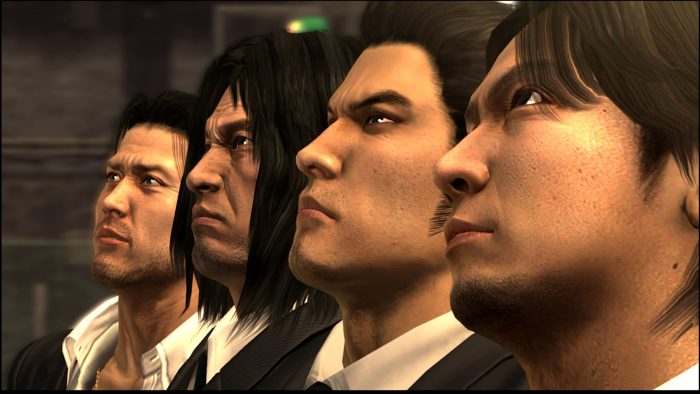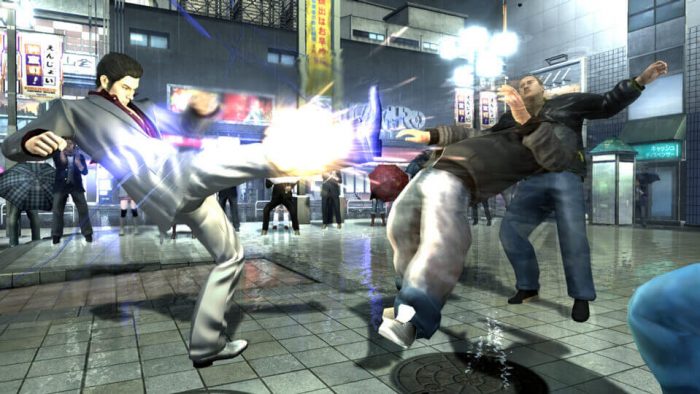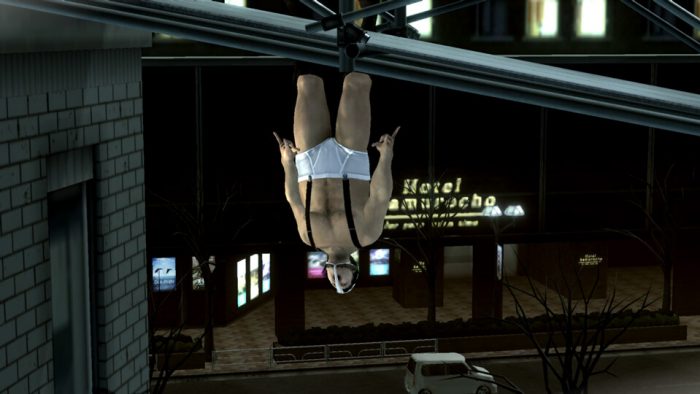Scroll down for a video review of The Yakuza Collection Remastered!
Part of the fun of playing a compilation of remasters is that you get a chance to see how the series evolved over time. In the case of the Yakuza series, the third entry was an incredible step forward, moving away from the fixed camera angles and blocky graphics of the PS2 to an open world and the smoother animation of the PS3. Yakuza 4 Remastered doesn’t quite repeat that innovation, but it does provide the gameplay foundation for some of the best future titles in the series.
The Tojo Clan is in crisis! With Chairman Daigo Dojima weakened by recent events, basically everything in the previous three games, the Ueno Seiwa clan looks to take advantage by moving into the Tojo territory of Kamurocho. The plot unfolds through the stories of four different protagonists, each with their own chapters. They are Akiyama, a loan shark with a heart of gold; Tanimura, a corrupt cop with a heart of gold; and Saejima, a convicted murderer on death row with a heart of gold. Together, they uncover a web of betrayal, murder, and tragedy that will reshape the future of the Tojo clan forever.
And then Kiryu shows up for some reason.

I understand why the developers would want Kazuma Kiryu to be part of Yakuza 4. After all, he is the face of the franchise. Unfortunately, his presence in Yakuza 4 feels entirely unnecessary. Our new protagonists fill his shoes quite nicely, giving us a fresh perspective on the world of Kamurocho. But once Kiryu shows up, they are mostly forgotten. There is even a scene where, after you beat the hell out of Tanimura and Akiyama as Kiryu, they ask: “Who is this guy?!” I admit, I had a similar reaction. Unlike the other three, Kiryu doesn’t have much of a personal stake in the plot. He is only there because, well, this is a Yakuza game. I wish the developer had dared to leave everything in the hands of our new protagonists, with Kiryu featuring only in a brief “Yakuza Dad” cameo rather than as a main character.
Having multiple protagonists also somewhat reduces the focus on the supporting cast. Interesting characters are introduced only to be forgotten and never seen again. Major supporting characters die off screen, simply because there isn’t any room for them to do so in the plot proper. It’s a shame that the villains aren’t given more development, as they are all compelling, each seeing themselves the “good guy” with somewhat admirable aims. The use of multiple protagonists also interrupts the flow of the overall plot. While it starts out very strong in the individual chapters, it goes completely off the rails by the end of the game, with way too many tangents focusing on police corruption, triple agents, and plot threads that tie all the way back to the original Yakuza on PS2.
One benefit of having new protagonists is that you see Kamurocho through someone else’s eyes. All of the locations that we’ve come to know and love (Serena, Millennium Tower, etc.) hold no significance for most of the playable characters. As them, you get to explore Kamurocho “fresh,” seeing different sides of the city, including the rooftops, underground sewers, and parking lots. It’s also fascinating to meet familiar Yakuza faces for the “first” time, seeing a new side of them. For example, it seems that fan-favorite Majima is considerably more restrained when not interacting with his beloved Kiryu-chan.
You might think the biggest innovation in Yakuza 4 is the addition of multiple player characters, but I would argue that the introduction of different combat styles had a larger impact on the series as a whole. Up until now, we were stuck with Kiryu’s Dragon style. Now, depending on the character, we have a quick but weak style, a strong but slow style, and a style built around dodging. This livens up the combat in Yakuza 4 substantially, primarily because you can’t simply rely on Kiryu’s Tiger Drop to dominate in every battle (at least, not until the last chapter).

The lack of a shared inventory is a real frustration in Yakuza 4. In the reality of the game, it’s understandable why characters who don’t know each other wouldn’t be able to share inventory items. In terms of gameplay, though, it’s incredibly irritating. It isn’t like each character has their own isolated location with its own item pool: they all share the same world space. Find an item in one chapter, it won’t be there in the next. As Akiyama, I hunted down the majority of the locker keys throughout town but wasn’t able to open the lockers as any other characters, effectively locking them until the final chapter. It will be interesting to see if they address this issue in Yakuza 5. Maybe have a “lost and found” box?
Substories and minigames are now divided by story section, meaning that you can’t tackle them unless you are playing as a specific character. If you miss something in one section, you won’t be able to do it until the finale. For the most part, minigames are recycled from Yakuza 3. In fact, most of the Kamurocho locker key locations are identical to where they were in the last game. Not that I mind having an edge when it comes to locker key hunting, but it does make this world space feel more like a photocopy rather than the city one year after the previous game.
Along with the bountiful substories, each character has their own specific minigame. Tanimura and Kiryu both have short quests where they team up with a new group of crime fighters called the Kamurocho Guard. These are entirely beat-’em-up sections where you make your way through enemies until you find the big boss, then, well, beat them up. Akiyama and Saejima, on the other hand, have more traditional minigames. The Hostess Training minigame is lifted wholesale from Yakuza 3 and given to Akiyama (which makes sense as he owns a hostess club). Tragically, it’s still as mind-numbingly boring as it was in the last title. You walk around the club floor, listening to what patrons want, then dress and train your hostess to match their desires. Saejima’s minigame, Fighter Maker, is a little more interesting, as you train students to fight in the Coliseum. However, much like with the Hostess Trainer, it becomes tedious after you’ve completed training your first student. Thankfully, all of these minigames are skippable if you decide they aren’t your speed.

Much like the substories and minigames, the graphics of Yakuza 4 are almost identical to Yakuza 3, which is understandable because they use the same engine. Textures are blurry, pedestrians sport the same stiff walking animation, and NPCs and random enemies have poorly-rendered faces. This was, of course, a limitation of the original hardware, but the high-definition remaster certainly brings these flaws to the fore. That said, the game isn’t ugly. Kamurocho looks as impressive as ever, with secrets hiding in every corner.
The voice acting here is simply fantastic, as per usual, with the new characters giving compelling performances that fit perfectly into the world of Yakuza. The remaster of Yakuza 4 offers a brand-new performance, compared to the PS3 version. The actor who previously provided the voice and likeness of Tanimura faced allegations of drug charges in 2016, resulting in an entirely new appearance and voice for the character. Having never played the original, I can’t exactly compare the two performances, but the new actor does a great job of portraying the “corrupt” cop.
I walked away from Yakuza 4 having had a much more fulfilling experience than I did with its immediate predecessor. The new characters revitalized the old “Tojo clan is in trouble” plot, and the different combat styles brought new life to the never-ending street brawls. I do wish that the developers left Kiryu out, as his addition feels unnecessary. Yakuza 4 brings the series ever closer to its modern-day iterations, with enough polish to be playable for newer fans of the series. I look forward to seeing what the last part of the Yakuza Remastered Collection brings us!



